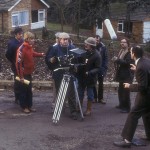13th Episode Of Fawlty Towers? Basil and Numerology? Interview with Lars Holger Holm – Author of "Fawlty Towers – A Worshipper's Companion"
This post was archived from the original website for Fawlty Towers Revisited, which premiered on public television in 2005.

It’s hard to put down Fawlty Towers – A Worshipper’s Companion. It’s such an engrossing compendium of Things Fawlty That You’ve Always
Wondered About and Those You’ve Never Thought Of. And of course, there is the script for the never-broadcast 13th episode that author Lars
Holger Holm states that he viewed in 1999. (See related story below about book and more must-have collectibles for Fawlty Towers fans.)
When I was reading the book, questions kept popping into my head, Questions primarily about Holm’s inspiration for investing the time to research and write such an insightful and thought-provoking book — with chapters on the Fawtly Towers’ connection to the occult, historical references and analysis of all of Basil’s neuroses — about a British sitcom with only 12 episodes that first aired some 30 years ago only on BBC 2?
I mean consider his curriculum vitae:
Lars
Holger Holm was born in Stockholm, Sweden. Enchanted by the universal
language of music, he began playing the violin at the age of seven.
Early in his career he formed the Swedenborg String Quartet, which
extensively toured Europe and the United States. A fervent student of
world literature and philosophy, Lars has also produced a body of
critical essays published in various newspapers and magazines. The
writer served as a music critic to Stockholm’s major newspapers Svenska
Dagbladet and Expressen. For several years he was a well known and
popular host of classical music on Stockholm’s Classic FM.
A list of his published works and translations from French, German and English includes:
Published Works
Come Snow. Psychic thriller, Leo Publishing 2005
Fawlty Towers – A Worshipper’s Companion, Leo Publishing, 2004
Dionysos – A Sinuous Essay to Divine the Universe, Leo Publishing 2002
Gothic Transformations, Leo Publishing, 2002
The Dream of Ultima Thule – And other Germanic Utopias, Leo Publishing 2002
The Antechamber of Hell, Leo Publishing, 2001
A Writer’s Guide, Ordfront, 2000
Sunset over Babel, Leo Publishing, 1999
Translations
C. Baudelaire: Le peintre de la vie moderne. “Det moderna livets målare”. Leo Publishing 2005
F. Nietzsche: Jenseits von Gut und Böse. “Bortom gott och ont”, Symposion, 2003
J. Lantz: La chute de Sophie. “Sophies fall”, Leo Publishing , 2001
C. Baudelaire: Le spleen de Paris. “Den ensamme flanören”. Extensive introduction by the translator. Leo Publishing , 2000
R. Noll: The Jung Cult. “Jungkulten”, Ordfront, 1997
Now, aren’t you curious, too? Well then, read on. I think you will find his answers equally enlightening and entertaining.
Q:
You have a diverse and esteemed career in music, literature and as an
author. Most of your work has been in the classical vein. So why the
detour to deconstruct and embellish a pop culture icon such as Fawlty
Towers?
Stuffed as my ears and brain had been with Brahms – bloody “Brahms’ third
racket!”
-, realising that I had finally become an insignificant relic of a
bygone era, I one day decided to leave my ivory tower to seek the
cultural interface where my enthusiastic temper could still possibly
make contact with a modern world of which I was still largely ignorant.
However, I soon realised that the only thing in this world which had
ever met with massive popularity without hurting my delicate sense of
decorum, paradoxically was another moss-overgrown relic from the past.
It suited me perfectly that he was not even a real person. But one
thing I could never understand was why they laughed at him. “What are
you laughing at?” I kept asking imaginary spectators, “The man is
right. In addition, he has the audacity to express his convictions in
less than uncertain terms. I like him, and for your benefit I’ll make
him the hero of my next book.”
Q:
You note that you believe that on one level, writing Fawlty Towers was
great divorce therapy for John Cleese and Connie Booth. And it seems as
if writing Fawlty Towers — A Worshipper’s Companion, was a
similar exercise for you. Were you a Fawlty Towers fan before your
divorce? Or did you come across it during or afterward and become taken
with its description of “the horrors of being married”?
A:
I did not see Fawlty Towers when it first came out, since in those days
I was far too busy running after my own Dulcinea of Toboso to have the
patience to sit down and watch TV. It must have been sometime in the
latter half of the 1980s that I first came across this inimitable
master piece. And yes, absolutely. It was not until I had gone through
the purgatory of marriage and subsequent divorce that I fully realised
what a prophet, what a cry in the wilderness, this living,
larger-than-life statue of John Cleese himself actually is. He was my
comfort in the Valley of Death, he anointed my wounds with the balm of
perennial humour, he gave me the strength to believe in my destiny –
again … Oh great Basil, patron saint of all married men, to you
I owe my new life; it is for this very reason that my book is no
secular guide to a monument in ruins, but a “worshipper’s companion” to
a living truth!

Q: Several times in Fawlty Towers Revisited,
cast members discuss how one can find a way to feel for Basil even
though he’s such an awful, despicable character. Why is that?
A:
As I said. I have never understood the poor sods who find Basil
unsympathetic. I even find it disgraceful that his own creators indulge
in such unworthy considerations – it is almost like hearing Saint-Peter
deny his master. To me Basil is a genius, and like all true geniuses
endowed with an extraordinary capacity for exaggeration. This capacity
is not the simple result of meanness coupled with ignorance, but the
natural corollary of an exceptional imagination. The problem – and this
is the tragedy of Fawlty Towers – is that Basil is stuck in a domestic
situation far below his station. To have him running around as a
servant in a small hotel on the notoriously rain-ridden English Riviera
is like dumping Leonardo da Vinci in a noisy Kindergarten – with no
hope of ever getting out of there. No doubt, he too would have begun to
see terrifying giants and bewitched knights where others only see –
children.
Q: How did you develop the condensed biographies of Fawlty Towers’ inhabitants?
A:
I invented them. By extrapolating from what is known and can be known
about the regulars of the hotel, I created their biographies in the
image of what could have been. It is a little bit like Leibnitz’
conception of God. He didn’t create the best of worlds, but only the
best of possible worlds.
Q: What inspired you to research and investigate the occult of Fawlty Towers?
A: This
is the metaphysical dimension of their work. Already as members of the
Monty Python, John Cleese and Connie Booth took a special interest in
the arcane aspect of history. One only needs to recall that one of the
films they participated in bears the title Monty Python and the holy
Grail, the Grail being a perfectly illusive object, perhaps just an
“objectified” spiritual essence.
In the film Life of Brian, after which the members of the group took
farewell of one another and henceforth went separate ways, the Gnostic
themes are so prevalent that any spectator with some knowledge of the
alternative doctrines and interpretations of God’s kingdom that were
propagated in the early Christian era, simply can not disregard the
fact that the script writers, including Gnostic director Terry Gilliam,
constantly make references to secret doctrines and hidden messages. As
an example we have the ascension of Terry Jones as the mother of Brian
emerging out of an unfolding lotus-flower in the animated opening
scene. Another typical thing about Gnostics is that they habitually
make fun of dogma and, quite especially, all monotonotheism.
The occult reality is always there for those who have eyes to see and
ears to hear. The only thing I have done is to point out where the
heavenly and mundane worlds interact in Fawlty Towers. The old Jewish
arcane science par excellence is numerology, translating numerical
combinations into spiritual messages. In medieval Europe alchemy and
astrology were prominent sciences engaging even perfectly incorruptible
scientists such as Copernicus and Newton.
It is my belief that the alchemical quest for the Philosopher’s Stone,
implied in the series, has met with success in my work, since I have
unearthed for the reader the Holy Grail, that is, the illusive 13th
episode, symbol of Master J.C. himself. Seek, and thou shalt find!
Q: How long did it take you to research and write Fawlty Towers – The Worshipper’s Companion?
A: As
soon as the decision had been made to give Basil satisfaction in this
sublunary world, I applied myself to the task with the same dedication
as chroniclers of historically important people do when confronted with
an unusually talented individual. Only in this case I had the
additional advantage of operating in a hermetically sealed universe –
or so I believed.
With twelve unalterable episodes, each one a disciple of the Master,
and a few apocryphal commentaries collected from the net and various
publications, I realised that all I needed to do was to study every
scene of the shows with the same attention as a chess master
scrutinises every new position on the chess-board. I then applied my
analyses and commentaries to every new significant position, and it
turned out that practically every move in these games are worth
commenting upon. Besides, I only consider my modest contribution to the
Towers as a pioneering work to be continued, expanded and completed by
other researchers in the field.
As for
the practical side of this task, I took my time (at least a year or so)
to collect the material and make notes of everything I could come to
think of in relation to the theme. Most of the actual writing of the
book was then made during the summer of 2003, when I isolated myself in
a little cottage in Provence, sat down in the shade of oaks and instead
of observing nature in her loveliness and beauty, observed the rules of
an hermetic game taking place inside a box with a screen. It should be
added that I did not at that time have access to the actual episodes,
let alone to a TV. Most of the material was written from memory and
only later checked against the script and the shows themselves. The
script of the book was edited for publication in the fall of that same
year and released in March 2004.

Q:
Is the 13th episode, “The Robbers”, for real? If so, why do you think
it was never broadcast, even in later years as a TV special?
A: I
have absolutely no idea why the 13th episode, called The Robbers, has
never been aired. I only know that I saw it once in Bill Morton’s flat
not far from Piccadilly Circus on a particularly wet evening. Hadn’t it
been for this, I might myself have doubted the otherwise striking
authenticity of the script, reproduced in the book.
As things stand, I can only assure the reader that the show, as far as
I remember, was amazing. Rarely have I seen John Cleese and his crew
reach such continuous heights of sublime entertainment, and the only
reason I can see for not wanting this episode to reach the fans, is
that it would perhaps create the false impression that there was so
much more to wring out of the material, whereas, in fact, the 13th
episode represents the ultimate solution to the problem of how to carry
this tormented universe to a happy end.
As concerns the reason for never admitting its existence, let alone
airing it, I must refer the reader to the BBC. They should know why.
And poor Bill. The last time I tried to call him he had a parrot
recorded on his answering machine, exclaiming: P-off!
Q: Given all of the time and research you have dedicated to Fawlty Towers, and writing Fawlty Towers – The Worshipper’s Companion,what one element do you think was key to its enduring appeal and popularity throughout the past 30 years?
A: Sadly,
I think it is the line “Don’t mention the war!” in connection with
Cleese’s Hitler-impression. Actually, this clown routine is a straight
loan from the Monty Python sketch “The Department of Silly-Walk”. I
would have omitted it as irrelevant in the context, but it is
absolutely true that Cleese here scored sky-high in general popularity
and probably will go down in history with it. Well, we all have our
cross to bear.
Q: How would Nietzsche describe/summarize Fawlty Towers?
A:
Man is something that rather not be. His sole justification lies in
surpassing himself, in sacrificing himself for a greater being, for
Super Man as my formula has it. Basil Fawlty, by virtue of being an
English Pig-Dog, a miserable utilitarian, in short, a mediocre
philosopher, is also, alas, the protagonist of a lamentable travesty of
tragedy.
To this unprecedented low level of decadence has our civilisation
reached, that contemporary drama does not even present us with real
persons any longer, but with buffoons and riff-raff pulled out from the
nearest Spanish taverna.
– But Mr. Nietzsche, maybe you are mistaking the half-wit Spanish waiter Manuel for Basil Fawlty?
– What? I need my glasses to hear what you are saying. That, that is Basel, nicht wahr?
– No, no, that is Manuel, he is supposed to be funny.
– Aha, and who is zis crazy woman then, his sister?
– No, that’s Sybil, Basil’s wife.
– Well, she does look a bit like a sister, mine at least … ha, ha, ha! Look, the little guy just fell down the stairs and then he placed a
cake in the face of another little ridiculous man. That was really
funny. I think I begin to like zis, what did you call it, Fawltry
Cowers. But what is zis? “Don’t mention the war?” Why? I greet every
sign that a new heroic age of war is approaching. That’s wrong. It
should be, “Stop talking about war – just do it!”. By the way, I
believe I just gave mankind another immortal slogan to live by. I shall
no longer listen to zis crap of Faulty Powers.
In: Archive



